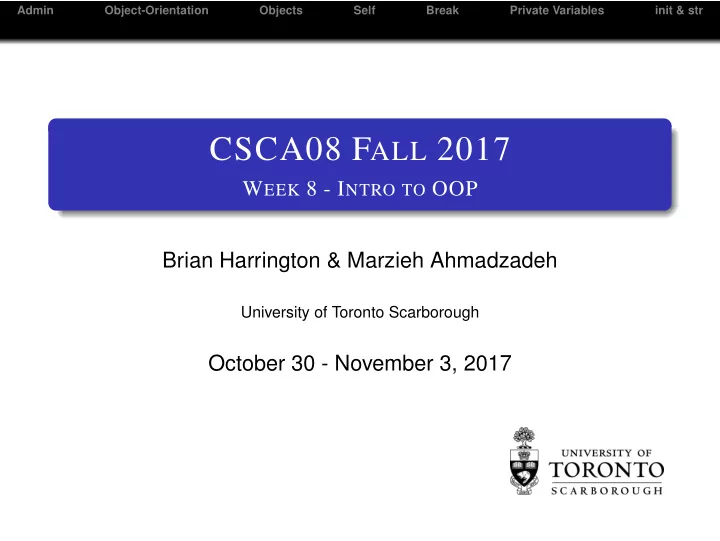

Admin Object-Orientation Objects Self Break Private Variables init & str CSCA08 F ALL 2017 W EEK 8 - I NTRO TO OOP Brian Harrington & Marzieh Ahmadzadeh University of Toronto Scarborough October 30 - November 3, 2017
Admin Object-Orientation Objects Self Break Private Variables init & str A DMIN • TT2 • Details on course website • Covers everything up to and including dictionaries (week 7 lecture, week 8 tutorials + inverted) • Beware the code mangler
Admin Object-Orientation Objects Self Break Private Variables init & str D EFINING OUR OWN T YPES • We’ve seen a bunch of types so far ( int , float , list , dict ...). • Now it’s time to define our own
Admin Object-Orientation Objects Self Break Private Variables init & str O BJECT O RIENTATION : A N EW P ARADIGM • Until now: Functions were the focus • my_function(data) : One global function that gets data passed to it • Object Oriented Approach: • my_obect.method(data) : The object has its own methods and data
Admin Object-Orientation Objects Self Break Private Variables init & str S OME TERMINOLOGY • Class: The type of an object • Object: An instance of a class • Method: Like a function, but belongs to a class • We’ve already seen this: • my_string = str(12.57) • my_string.ljust(10) • my_string is an object , of the str class, and we called string’s ljust method on it
Admin Object-Orientation Objects Self Break Private Variables init & str C REATING O BJECTS • Create a class: class ClassName(): • (We’ll see what the brackets are for later) • CamelCase (not pot_hole_case) • define a method def method_name(self) • Looks very similar to defining a function • Indented inside the class • We’ll see what the self does in a minute • can now create a new object of type ClassName • my_object = ClassName() • our new object can now access the methods we defined • my_object.method_name()
Admin Object-Orientation Objects Self Break Private Variables init & str S ELF • Every method (including the built in ones) gets implicitly passed a copy of the object upon which it was called • We don’t include it in the method call, but we do in the method definition • This allows a method to access the object on which it was called • We normally call this copy of our object self • Behind the scenes: my_obj.method() is really just an alias of Class.method(my_obj)
Admin Object-Orientation Objects Self Break Private Variables init & str B REAK WARNING: Scary Halloween Image Ahead
Admin Object-Orientation Objects Self Break Private Variables init & str B REAK
Admin Object-Orientation Objects Self Break Private Variables init & str W HAT ’ S W ITH ALL THE U NDERSCORES ? • Already saw, we can do: my_object.variable • This is bad. Why? • External code relying on internals of class • We should be able to change internals without worrying about breaking external code • Like the difference between internal/external documentation • This will be a major topic in A48 • using underscores = people unlikely to guess variable names • Really: Just a way of saying “Hands off my variables" • Doesn’t actually stop external code, if they know the variable name, they can still access/change it. • Security through obscurity/convention
Admin Object-Orientation Objects Self Break Private Variables init & str B UILT - IN M ETHODS • __init__ • Initialize: this is known as a constructor method • Defines the code that runs when we first create a new object of this type • Usually used to set up the default parameters • __str__ • Return what you want to output when an object of this class is cast to a string (or printed)
Recommend
More recommend